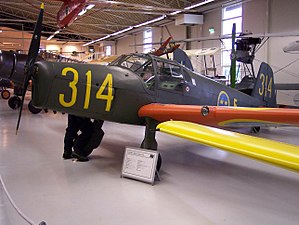Bücker Bü 181 Bestmann
| Bü 181 Bestmann | |
|---|---|

| |
| One of 125 Swedish-built Bücker Bü 181 | |
| Role | Advanced trainer |
| Manufacturer | Bücker |
| First flight | February 1939 |
| Primary users | Luftwaffe Czechoslovakia Egypt Sweden Switzerland |
| Number built | 3,400 |
The Bücker Bü 181 Bestmann (Best Man) is a two seater, single engine trainer aircraft built by Bücker Flugzeugbau GmbH in Johannisthal, Berlin and extensively used by the Luftwaffe in World War II.
Development
The prototype Bü 181 (D-ERBV) made its maiden flight in February 1939 with Chief Pilot Arthur Benitz at the controls. After thorough works and official flight testing by the Reichsluftfahrtministerium (RLM) the Bü 181 was nominated to be the standard primary trainer for the Luftwaffe. Series production of the Bü 181 commenced in 1940/41. The types were designated A to D with only slight variations between each and could be powered either by the Hirth 500A or 504 engine.
Description
The Bü 181 Bestmann is powered by a 105 hp four cylinder Hirth HM 504A piston engine. The Bü 181A aircraft is a single-engine low wing monoplane with fixed undercarriage, air-cooled 4-cylinder HM 500 A engine, split flap, twin controls and two adjustable seats arranged side-by-side. The cabin section of the fuselage is of a tubular steel frame construction whereas the rear of the fuselage has a wooden shell. The wing assembly and tail unit are also of wooden shell construction. All the rudders, elevators and ailerons have wooden ribs and are covered in fabric.
The aircraft is designed for training flights, pleasure trips and aerobatics. Its strength corresponds to Stress Group 5 with a limited load (single occupancy) and Stress Group 4 fully laden.
Production
The Bücker factory at Rangsdorf built most of the Bü 181's, but because of demand was forced to license the design to the Fokker Company in the Netherlands, who subsequently built 373 of the type for the Luftwaffe all of which were delivered by the end of 1943.
Production of both the Bü 181A and the slightly modified Bü 181D was begun by Fokker in Amsterdam in 1942 and its total wartime production was 708 aircraft. Between 1943 and 1945, Hägglund & Söner AB in Sweden built 125 Bü 181's with the Hirth 500A engine with the Swedish military designation Sk 25. Just prior to the German withdrawal from Czechoslovakia, production of the Bü 181D was initiated in the Zlín plant at Otrokovice, and production continued after the war, as the C.6 and C.106 for the Czechoslovak Air Force and as the Zlín Z.281 and Z.381 in various versions for civil use.
During the 1950s the Heliopolis Aircraft Works of Egypt acquired a Czechoslovak licence to produce the Bestmann in versions similar to the Zlín Z.381 with a 105 hp Walter-Minor engine. It was produced for the Egyptian Air Force as the Gomhouria (meaning "Republic") and subsequent versions were supplied to other Arab air forces. At least 300 Gomhourias were built.[1]
In all, 3,400 aircraft were built although only a handful survive today.
Service
Although built as a primary trainer for the Luftwaffe, the type also performed other duties such as communication, glider towing, and even transporting Panzerfaust weapons (a rocket projectile with a hollow-charge warhead used as an infantry weapon against tanks.)[2]
Famous test pilot, and sister-in-law of Claus von Stauffenberg, Melitta Schenk Gräfin von Stauffenberg was flying a Buecker 181 when she was shot down and fatally wounded in 1945. [3]
Variants
- Bu 181
- Prototype.
- Bu 181A
- Two-seat primary trainer aircraft.
- Bu 181D
- Two-seat primary trainer aircraft. Slightly modified version, with only minor improvements.
- Zlín Z.181
- Two-seat primary trainer aircraft. Czech production version of the Bu 181D, built by Zlín in Czechoslovakia after the war.
- Zlín Z.281
- Two-seat primary trainer aircraft, powered by a Toma 4 piston engine.
- Zlín Z.381
- Two-seat primary trainer aircraft, powered by a 105-hp (78-kW) Walter Minor piston engine. Czech Air Force designation C-106.
- Gomhouria Mk I
- Two-seat primary trainer aircraft, powered by a Walter Minor piston engine. Egyptian production version of the Zlín 381, built under licence in Egypt by the Heliopolis Aircraft Works.
- Gomhouria Mk II
- Two-seat primary trainer aircraft, powered by a 145-hp (108-kW) Continental C-145 piston engine.
- Sk 25
- Swedish Air Force designation of the Bucker Bu 181.
Operators
 Algeria - Gomhouria
Algeria - Gomhouria Croatia
Croatia
 Czechoslovakia
Czechoslovakia
 Egypt
Egypt
- Egyptian Air Force - Gomhouria
 Germany
Germany
 Hungary - Postwar.
Hungary - Postwar. Poland - Postwar.
Poland - Postwar. Sweden
Sweden
 Switzerland
Switzerland
Specifications
Data from The Concise Guide to Axis Aircraft of World War II [4]
General characteristics
- Crew: Two
Performance
See also
Related lists
References
- Notes
- Bibliography
- Donald, David and Lake, Jon. (editors). Encyclopedia of World Military Aircraft. London: Aerospace Publishing, Single volume edition, 1996. ISBN 1 874023 95 6.
- König, Erwin. Bücker Bü 181 "Bestmann" (Flugzeug Profile 30) (in German). D-86669 Stengelheim, Germany: Unitec Medienvertrieb e.K.
- König, Erwin. Die Bücker-Flugzeuge (The Bücker Aircraft) (bilingual German/English). Martinsried, Germany: Nara Verlag, 1987. ISBN 3-925-671-00-5.
- König, Erwin. Die Bückers, Die Geschichte der ehemaligen Bücker-Flugzeugbau-GmbH und ihrer Flugzeuge (in German). (1979)
- Mondey, David. The Hamlyn Concise Guide to Axis Aircraft of World War II. London: Chancellor Press Ltd, 1996. ISBN 1-85152-966-7.
- Smith, J.Richard and Kay, Antony L. German Aircraft of the Second World War. London: Putnam and Company Ltd., 3rd impression 1978, p. 94-96. ISBN 0-370-00024-2.
- Wietstruk, Siegfried. Bücker-Flugzeugbau, Die Geschichte eines Flugzeugwerkes (in German). D-82041 Oberhaching, Germany: Aviatik Verlag, 1999. ISBN 3-925505-28-8.
- Wood, Tony and Gunston, Bill. Hitler's Luftwaffe: A pictorial history and technical encyclopedia of Hitlers air power in World War II. London: Salamander Books Ltd., 1977, p. 140. ISBN 0-86101-005-1.
